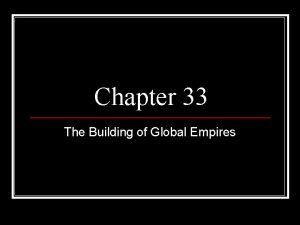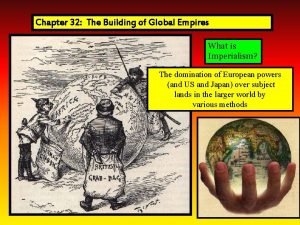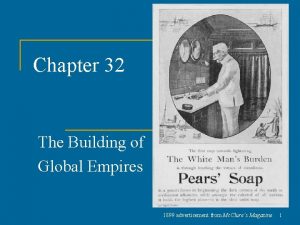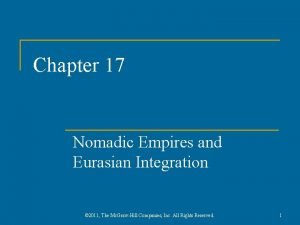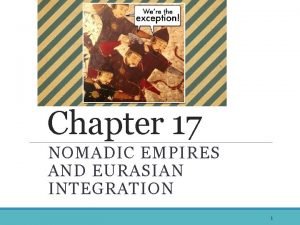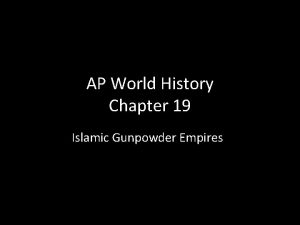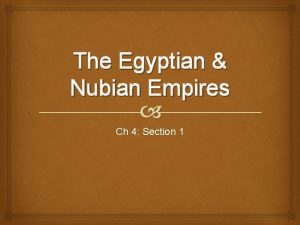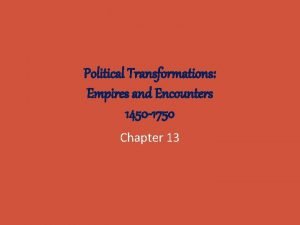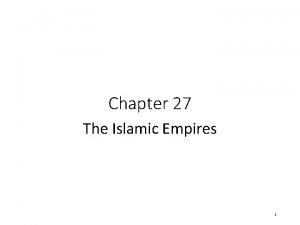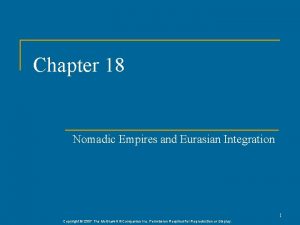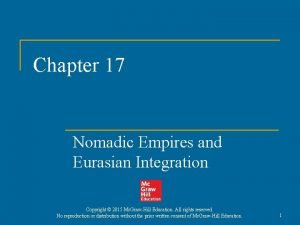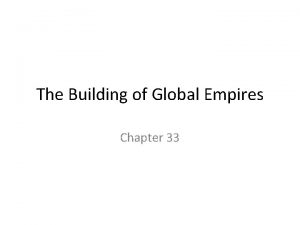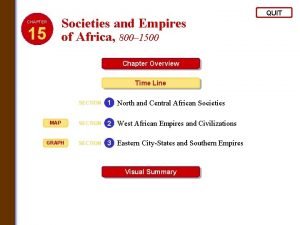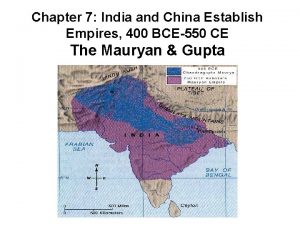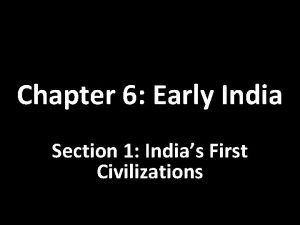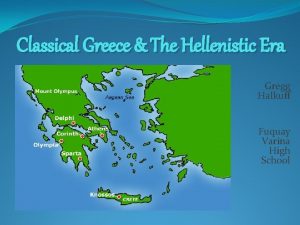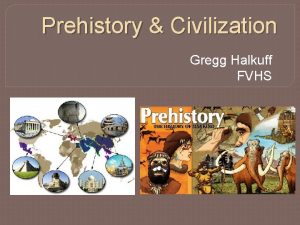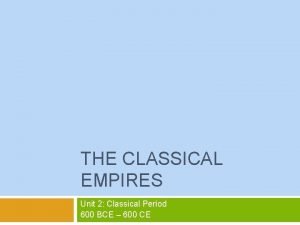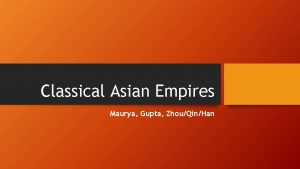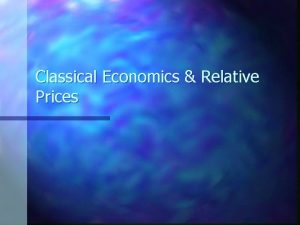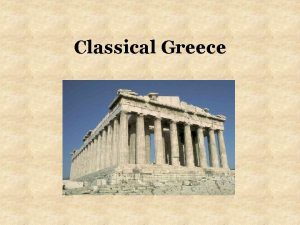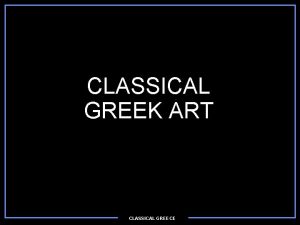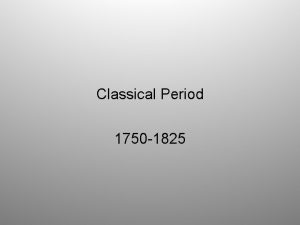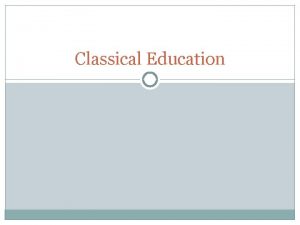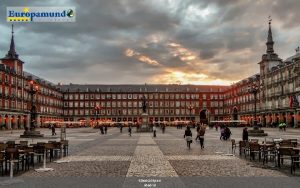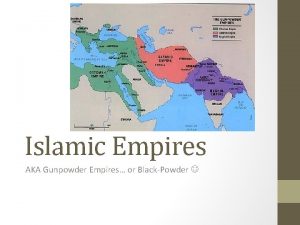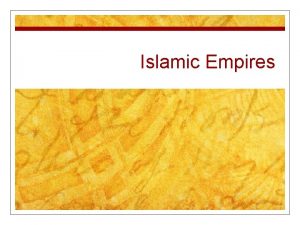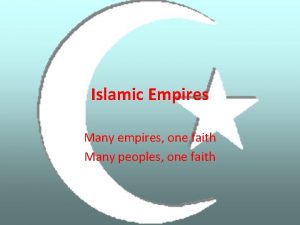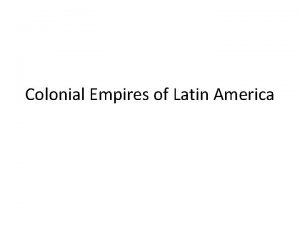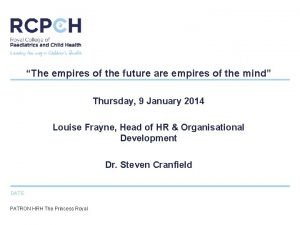The Classical Empires CHAPTER 3 Mr Halkuff AP











































- Slides: 43

The Classical Empires CHAPTER 3 Mr. Halkuff AP World History Fuquay-Varina High School

Population Growth

Urbanization

Afro-Eurasia in 500 BCE

Afro-Eurasia in 350 BCE

Afro-Eurasia in 200 BCE

Afro-Eurasia in 100 CE

Persian Empire

Persian Empire (558 -332 BCE) v v Founded by Cyrus the Great Darius I (521 -486 BCE) n n Balanced central administration & local governors Divided government into 3 districts ran by satraps Built the Royal Road Fought Persian Wars (500 -479 BCE) p Led to the decline of the Persian Empire

Persian Empire v Persian Society n n v Persian Economy n n v Women worked in textile manufacturing Government used slaves to complete public works projects Government coined money Facilitated trade from Greece to India Persian Religion n Zoroastrianism

Classical China v Zhou Dynasty (1029 -258) n n v Decline of Zhou Dynasty n n n v Mandate of Heaven Feudalism Confucianism Daoism Legalism Warring States Period n Kingdom of Qin began expanding during the 3 rd century BCE

Qin Dynasty (221 -202 BCE) v v Used Legalism to restore order Land reforms weakened aristocracy n v v Peasants were given land rights to farm remote territories Centralized bureaucracy Unified China n Standardized script, laws, and weights & measures

Qin Shi Huangdi v v Proclaimed himself “First Emperor” of China Centralized Power n n v v Disarmed local militaries Built roads & defensive walls Demanded burning of books Used forced labor to complete public works projects

Terra Cotta Army

Terra Cotta Army

Early Han Dynasty (202 BCE-9 CE) v Founded by Liu Bang n v Conquered northern Vietnam, Korea, and Central Asia n v Longest dynasty in Chinese History Tribute System Monopolized iron, salt, and liquor

Han Wudi (Wu Ti) v Ruled from 141 -87 BCE n v Two Goals n n v Supported Legalism Centralize government Expand the empire Reforms n n Expanded bureaucracy Started an imperial university Confucian examination system Expanded the Silk Roads

Chinese Accomplishments v Technology n n n v Paper Collar harness & improved plow Wheelbarrow Watermill Seismograph Science n Daoism emphasized importance of nature

Mauryan Dynasty- 323 BCE-185 BCE v Founded by Chandragupta Maurya n Arthashastra- ruling guide

Ashoka (268 -232 BCE) v Conquered most of India n n v Reforms n n v v Used elephants in warfare Battle of Kalinga Pillars of Ashoka Centralized bureaucracy Expanded agriculture Built roads to promote trade Promoted the spread of Buddhism Empire declined after Ashoka’s death

Gupta Dynasty (320 -565 CE) v Founded by Chandra Gupta n v Gupta Government n n v Used alliances, tribute & conquest Coalition of regional kingdoms Policy & administration left to local rulers Eventually destroyed by the White Huns

Indian Accomplishments v Science n n Calculated the solar year as 365. 358605 Two medical texts classified 1, 000 diseases Performed surgery including plastic surgery Inoculations against smallpox v Mathematics n n v Indian numerals (0 -9) Decimal system Negative numbers Calculated the numerical value of pi Literature n Poetry p n Sinbad the Sailor, etc. Drama p Mahabharata & Ramayana

Ancient Greece v Geography prevented political unification n v City-States n n v Cities offered safety and wealth Different political systems Unified when threatened n v Culturally unified Persian Wars weaken city-states n Peloponnesian War (431404 BCE)

Greek Colonization

Alexander the Great (332 -323 BCE) v v Father, Philip II, conquered most of Greece Built a massive empire n v Threatened India Empire divided after his death

Hellenistic Empires

Greek Accomplishments v Philosophy n n n v Socrates – Ethics, Socratic Method Plato – Government & ethics Aristotle – Ethics, government, science, etc. Math & Science n n Euclid’s Elements Pythagoras developed Pythagorean theorem Eratosthenes calculated the Earth’s size Archimedes estimated the value of pi, law of lever, pulley systems, catapult, etc.

Architecture The Parthenon

Roman Republic (509 -44 BCE) v Political System n n n v Military expansion n v Consuls Senate (patricians) Tribunes (plebeians) Assimilated conquered peoples Twelve Tables n n Created a standardized system of laws Established rights for defendants

Expansion of Roman Republic

End of Republic v v Growing tensions between rich & poor Latifundias n v Large plantations in conquered lands controlled by aristocrats Julius Caesar n n Dictator for life in 44 BCE Reforms p n Sought to relieve tension between the classes Executed by aristocratic conspirators

Roman Empire (31 BCE-476 CE) v Established by Augustus n n v NOT a dynasty n v v Continued military expansion Pax Romana Succession often depended upon military strength Tolerated local customs & religions Laws & patriotism held empire together

Roman Aqueducts

Circus Maximus

Other Structures

Fall of the Roman Empire 164 – Antonian Plague spreads through Rome 180 – End of Pax Romana 300 – Diocletian divides the Empire 313 – Constantine legalizes Christianity 410 – Visigoths sack Rome 455 – Vandals sack Rome 476 – Fall of the Western Roman Empire

Germanic Invasions

Maya (300– 900 CE) v v Heirs to Olmec traditions Culturally unified citystates n v Built elaborate religious and commercial centers n v v Never form a unified political system Tikal & Chichen-Itza Traded luxury products Advanced math & science n Zero, solar year, etc.

El Castillo at Chichen-Itza

Mayan Architecture

Mayan Oberservatory


Mayan Decline Maya city-states were abandoned or destroyed between 800 -900 CE v Causes for decline include: v n n n The disruption of trade after the decline of Teotihuacan in Central Mexico Environmental degradation caused by overpopulation Epidemic disease
 Maritime and land based empires differences
Maritime and land based empires differences Chapter 33 the building of global empires
Chapter 33 the building of global empires Chapter 32 the building of global empires
Chapter 32 the building of global empires Chapter 32 the building of global empires
Chapter 32 the building of global empires Chapter 17 nomadic empires and eurasian integration
Chapter 17 nomadic empires and eurasian integration Nomadic empires and eurasian integration
Nomadic empires and eurasian integration Chapter 19 islamic gunpowder empires
Chapter 19 islamic gunpowder empires Chapter 4 section 1 the egyptian and nubian empires
Chapter 4 section 1 the egyptian and nubian empires Chapter 5 political transformations empires and encounters
Chapter 5 political transformations empires and encounters Chapter 27 the islamic empires
Chapter 27 the islamic empires Chapter 27 the islamic empires
Chapter 27 the islamic empires Chapter 18 nomadic empires and eurasian integration
Chapter 18 nomadic empires and eurasian integration Chapter 17 nomadic empires and eurasian integration
Chapter 17 nomadic empires and eurasian integration Chapter 16 people and empires in the americas
Chapter 16 people and empires in the americas Chapter 33 the building of global empires
Chapter 33 the building of global empires Chapter 15 societies and empires of africa
Chapter 15 societies and empires of africa Chapter 7 section 1 india's first empires
Chapter 7 section 1 india's first empires Chapter 7 india and china establish empires
Chapter 7 india and china establish empires Chapter 7 section 1 india's first empires
Chapter 7 section 1 india's first empires Hình ảnh bộ gõ cơ thể búng tay
Hình ảnh bộ gõ cơ thể búng tay Ng-html
Ng-html Bổ thể
Bổ thể Tỉ lệ cơ thể trẻ em
Tỉ lệ cơ thể trẻ em Gấu đi như thế nào
Gấu đi như thế nào Tư thế worms-breton
Tư thế worms-breton Alleluia hat len nguoi oi
Alleluia hat len nguoi oi Các môn thể thao bắt đầu bằng tiếng nhảy
Các môn thể thao bắt đầu bằng tiếng nhảy Thế nào là hệ số cao nhất
Thế nào là hệ số cao nhất Các châu lục và đại dương trên thế giới
Các châu lục và đại dương trên thế giới Công thức tính độ biến thiên đông lượng
Công thức tính độ biến thiên đông lượng Trời xanh đây là của chúng ta thể thơ
Trời xanh đây là của chúng ta thể thơ Mật thư tọa độ 5x5
Mật thư tọa độ 5x5 Làm thế nào để 102-1=99
Làm thế nào để 102-1=99 độ dài liên kết
độ dài liên kết Các châu lục và đại dương trên thế giới
Các châu lục và đại dương trên thế giới Thơ thất ngôn tứ tuyệt đường luật
Thơ thất ngôn tứ tuyệt đường luật Quá trình desamine hóa có thể tạo ra
Quá trình desamine hóa có thể tạo ra Một số thể thơ truyền thống
Một số thể thơ truyền thống Bàn tay mà dây bẩn
Bàn tay mà dây bẩn Vẽ hình chiếu vuông góc của vật thể sau
Vẽ hình chiếu vuông góc của vật thể sau Biện pháp chống mỏi cơ
Biện pháp chống mỏi cơ đặc điểm cơ thể của người tối cổ
đặc điểm cơ thể của người tối cổ Thế nào là giọng cùng tên?
Thế nào là giọng cùng tên? Vẽ hình chiếu đứng bằng cạnh của vật thể
Vẽ hình chiếu đứng bằng cạnh của vật thể

